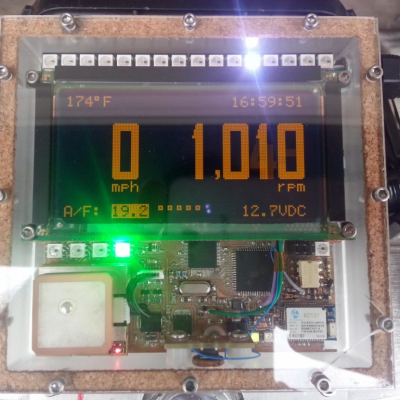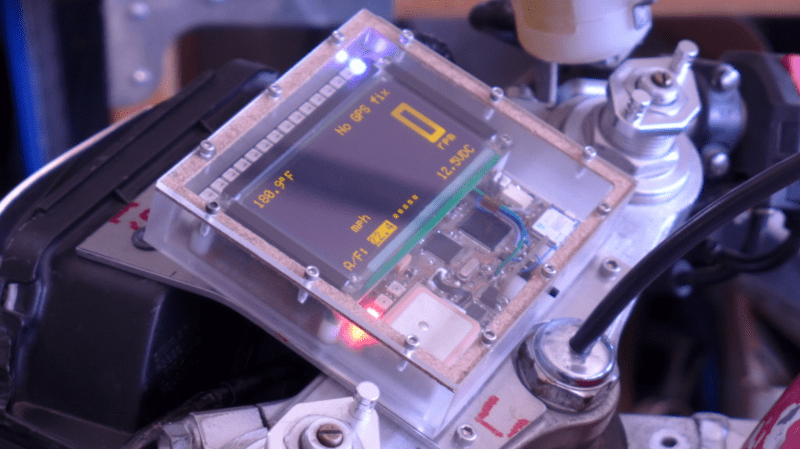[Josh] got rid of the standard, factory gauges on his GSXR Super-bike and installed a custom built instrument panel which displays some additional parameters which the regular instrumentation cluster did not. He was working on converting his bike in to a Streetfighter – a stripped down, aggressive, mean machine. The staid looking gauges had to go, besides several other mods to give his bike the right look.
 Luckily, he had the right skills and tools available to make sure this DIY hack lives up to the Streetfighter cred of his bike. The important parameter for him was to log the Air / Fuel mixture ratio so he could work on the carburation. Along the way, he seems to have gone a bit overboard with this build, but the end result is quite nice. The build centers around a Planar 160×80 EL graphic display lying in his parts bin. The display didn’t have a controller, so he used the Epson S1D13700 graphic controller to interface it with the microcontroller. An Atmel ATmega128L runs the system, and [Josh] wrote all of his code in “C”.
Luckily, he had the right skills and tools available to make sure this DIY hack lives up to the Streetfighter cred of his bike. The important parameter for him was to log the Air / Fuel mixture ratio so he could work on the carburation. Along the way, he seems to have gone a bit overboard with this build, but the end result is quite nice. The build centers around a Planar 160×80 EL graphic display lying in his parts bin. The display didn’t have a controller, so he used the Epson S1D13700 graphic controller to interface it with the microcontroller. An Atmel ATmega128L runs the system, and [Josh] wrote all of his code in “C”.
 Bike speed is derived through a GPS module. The air/fuel ratios are read from a wideband O2 sensor. Other data shown on the display are the engine temperature, battery voltage, time (from GPS), and engine RPM. An ambient light sensor is used to auto-dim the display. The high refresh rate of the display, up to 240Hz, allows a large dimming range without flickering. The light sensor also controls the brightness of the other indicators. A BC127 Bluetooth module allows datalogging via the Serial Port Profile (SPP). In the future, this would possibly allow him to display SMS messages from his phone on the display. A bank of addressable LED’s can be driven to show several functions – indicator lights, RPM, battery voltage, engine temperature or air / fuel ratio – selected using a push button.
Bike speed is derived through a GPS module. The air/fuel ratios are read from a wideband O2 sensor. Other data shown on the display are the engine temperature, battery voltage, time (from GPS), and engine RPM. An ambient light sensor is used to auto-dim the display. The high refresh rate of the display, up to 240Hz, allows a large dimming range without flickering. The light sensor also controls the brightness of the other indicators. A BC127 Bluetooth module allows datalogging via the Serial Port Profile (SPP). In the future, this would possibly allow him to display SMS messages from his phone on the display. A bank of addressable LED’s can be driven to show several functions – indicator lights, RPM, battery voltage, engine temperature or air / fuel ratio – selected using a push button.
[Josh] used his CNC to mill out the housing using a 1″ thick acrylic. And the nice looking PCB is designed in Eagle and milled out using the same CNC. It’s all SMD with a large smattering of 0805 parts and shows rev B – so he’s probably made improvements over rev A. Check out the video below where [Josh] walks through some of the functions.
















looks like a bomb. Must call FBI, CIA, and all other 3-letters departments!
DHS handles domestic propaganda I think.
+1
Hey, did you hear that the clock bomb moron self-deported. Now if only we could deport all the rest of the brain dead clock bomb idiot.
I am just relieved the kid wont be home schooled, which would have been tragedy on top of farce.
My only concern on that is daylight readability; I don’t know the screens, but it looked a bit indistinct with the reflections etc, and you really don’t want that on a bike. Otherwise, nice build.
How would you resolve that? Some kind of film or coating?
I believe you can get some kind of stick on film that reduces glare
Using a different type of screen such as an OLED or similar with high contrast would be one way to do it. The other would be coatings that reduce reflections.
vfd would be a pretty good candidate for this.
These displays are daylight readable. I have a bunch of them and there are pretty incredibly bright. They are a plasma display and also incredibly expensive. One of the major markets for the planar displays is military.
Anyone know what the white MFDs are in VW-group cars? They don’t seem to bleed light like LCDs, and are very daylight viewable.
Probably OLED. I’m looking at one right now for an arduino based gauge project I’m working on.
They don’t have the characteristic flicker of oled though…
Its certainly a gorgeous display. Im gonna have to see if i can track down a couple when im a little more flush.
” Along the way, he seems to have gone a bit overboard with this build,”
.
Nonsense, SpongeBob …
Planar’s EL screens are really nice, but spendy. And they have lackluster brightness halflives, and they’re usable but not that great for daylight viewing.
Great work, any chance you’ll release the code?
Are you using some kind of RTOS or just doing everything as fast as possible?
It looks like the engine RPM should be sampled a little faster (or maybe filtered), and other values less often (battery and temperature voltage, perhaps).
He did an excellent job on that. I don’t know if I’d personally trust my speed calculated via GPS, but other than that, excellent build.
i am with you on this one. using just the GPS for speed measurement is the only thing that is bugging me about this build. he is measuring the RPM, should have just measured the bikes own speed sensor as well. he can display the GPS speed on screen as long as it is available, but if the GPS does not work he could fall back to the sensor reading.
just one more thing, there i no mention about the calculation of the speed. most devices will just give you the horizontal speed, but not vertical. that leads to a wrong value for the actual speed of the vehicle when driving down- or uphill
not to mention driving in a tunnel
Many bicycle computers have provisions for using a wheel speed sensor precisely because GPS is lousy at distance measurement. It’s fine for speed, just a bit slow, and you need to wait for it to get a fix before you have a speedo.
The ideal solution would be using GPS to calibrate the wheel speed sensor automatically. Exact distances/speeds, instantly.
This automatic calibration is done at least by Garmin Edge 705 (possibly also other model). And it’s one of those things that take place without paying any attention and one doesn’t know to appreciate it unless it’s missing.
Love the build but he should have included a couple of analogue style gauges or atleast one for RPM, you can get a reading with a much faster glance on a gauge than a digital readout.
That’s one of the modes for the lights across the top.
sounds like his cam chain tensioner is failing….common problem on gsxr 750 engine….better check it out bcuz it causes catastrophic engine failure….valves touching pistons and other really unpleasant things that come after that happens…I used to race and build these bikes in the late 90 s….I had to learn the hard way…
Not so much. They normally sound like a garbage disposal. I’ve got an 85 with 80,000kms I’ve owned since new and it’s always sounded like hell; particularly when it’s cold at low idle. On the bright side, you can’t kill them. I’ve got three of them in total. Two were race bikes and one was somewhat abused before I got my hands on it and restored it.
Why does it say he wrote all his code in “C” with quotes?
too pretty for an old school streetfighter. the reason for these was more due to rashed plastics from wrecks not being replacable easily or cheaply. Can’t get a decent fairing, take it off, get stalks for the signals, ziptie the wiring, and use tape where neccessary. This display looks too nice for that aesthetic, would fit perfectly on a Zero SR or a “green” moped. thing about reading A/F is that you’re not adjusting that on a carb while running, and if you’re fuel injected, carburetion isn’t happening. Which I suspect that the gauge swap is being done more for function than meeting a “look”. Unless he wants to wrap it in duct tape.
It’s ok, this is the natural evolution of all GSX-R’s. Step 1) Buy a GSX-R. Step 2) Crash Step 3) convert into street fighter.
AFR actually is adjusted as a function of engine speed and load. Harleys even keep track of time-under-load, and start richening up the mixture in order to keep the rear cylinder cool.
I worked on a project that allows the rider to adjust fuel curves in the field. Our product divided the RPM range into low, mid, and high ranges and then allowed the user to add or subtract a certain amount of fuel within those ranges.
Shameless plug here, I listed my Planar display collection on ebay: http://www.ebay.com/sch/macona/m.html?item=231734621627&ssPageName=STRK%3AMESELX%3AIT&rt=nc&_trksid=p2047675.l2562